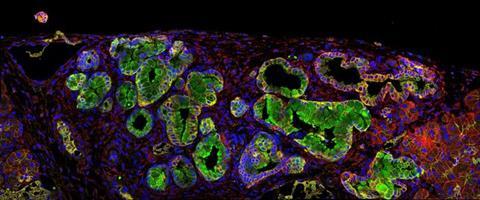Immunotherapy represents the new hope in the fight against cancer; however, not all tumors respond to this treatment. Pancreatic cancer is a type of tumor that does not respond to currently approved drugs and is therefore lethal for 9 out of every 10 people diagnosed.

For this reason, it is necessary to look for new targets that attack resistant cells, such as cancer stem cells, which are the main responsible for initiating the tumor, forming metastases and resisting treatment.
A recent study led by the Spanish National Research Council (CSIC), published in the journal Gut, describes how pancreatic cancer stem cells take advantage of an antibacterial protein, PGLYRP1, to evade the immune system and protect themselves from early elimination. When you remove this protein, the defenses are able to recognize the tumor cells and kill them. This will enable the design of new immunotherapies that act against the root cause of pancreatic cancer and, in the future, lead to improvements in therapy.
Root of the tumor
The study has been co-led by three researchers: Bruno Sainz, head of the Cancer Stem Cells and Fibroinflammatory Microenvironment group at the Sols-Morreale Biomedical Research Institute (IIBM), CSIC-UAM and the Biomarkers and Personalized Approach to Cancer (BIOPAC) group at the Ramón y Cajal Institute for Health Research (IRYCIS); Christopher Heeschen, from the Candiolo Cancer Institute (IRCCS) in Italy, and Susana García Silva, a scientist at the Spanish National Cancer Research Center (CNIO).
Over the past ten years, the three scientists have led a collaborative project in which they identified a population of pancreatic cancer stem cells (CSCs) present in mouse models of this disease. These cells, known as the root of the tumor, are responsible for disease recurrences after treatment with chemo- or radiotherapy. Interestingly, pancreatic cancer is also one of the most resistant tumors to immunotherapy. However, to date, the mechanisms by which CSCs manage to avoid elimination by the immune system are not clear.
As a result of this collaboration, Peptidoglycan Recognition Protein 1, PGLYRP1, was identified as one of the causes of immune evasion in CSCs, using sophisticated mouse models and patient samples. This work has described for the first time the role of this protein in pancreatic cancer, which is produced in excess in stem cells. The finding lays the groundwork for developing treatments against it.
Blocking the protein
“When we eliminate PGLYRP1 from tumor cells, we see that the immune system responds by attacking them, preventing the formation of the primary tumor and metastatic spread,” explains Bruno Sainz, group leader at IIBM. “We are now developing therapies to block or eliminate this protein with the hope of being able to combine them with current treatments to more efficiently attack and eliminate cancer stem cells, the root of the tumor,” he adds
Over the past four years, Juan Carlos López-Gil, first author of this work, has been able to decipher why CSCs produce this protein in pancreatic cancer. “We have seen that immune cells try to eliminate tumor cells by producing tumor necrosis factor, but PGLYRP1 is very similar to this factor and interacts with the same receptor, blocking it”.
For the researcher, this implies that “CSCs protect themselves by using an incomplete key (PGLYRP1) to block the lock (the receptor) and thus avoid the death caused by the tumor necrosis factor (the complete key)”.
Surprising discovery
What surprises the researchers is that a protein used by our immune defense system to combat bacteria is used by pancreatic cancer to protect itself from these same defenses. “It will be a priority in the future to understand the mechanisms by which tumor cells hijack physiological processes in order to ‘re-educate’ the environment surrounding the tumor to react against it,” says co-author García-Silva.
The research has been funded by the La Caixa Foundation, the Fero Foundation, the Pancreatic Cancer Association, the Spanish Association of Pancreatology, the Spanish Association Against Cancer, the Carlos III Institute and the Ministry of Science, Innovation and Universities, Innovation and Universities, as well as the gastrointestinal tumors program of CIBERONC.
Topics
- Antimicrobials
- Bruno Sainz
- Cancer Microbiology
- Candiolo Cancer Institute
- Christopher Heeschen
- CSIC-UAM
- One Health
- PGLYRP1
- Ramón y Cajal Institute for Health Research
- Research News
- Sols-Morreale Biomedical Research Institute
- Spanish National Cancer Research Center
- Spanish National Research Council
- Susana García Silva
- UK & Rest of Europe







No comments yet